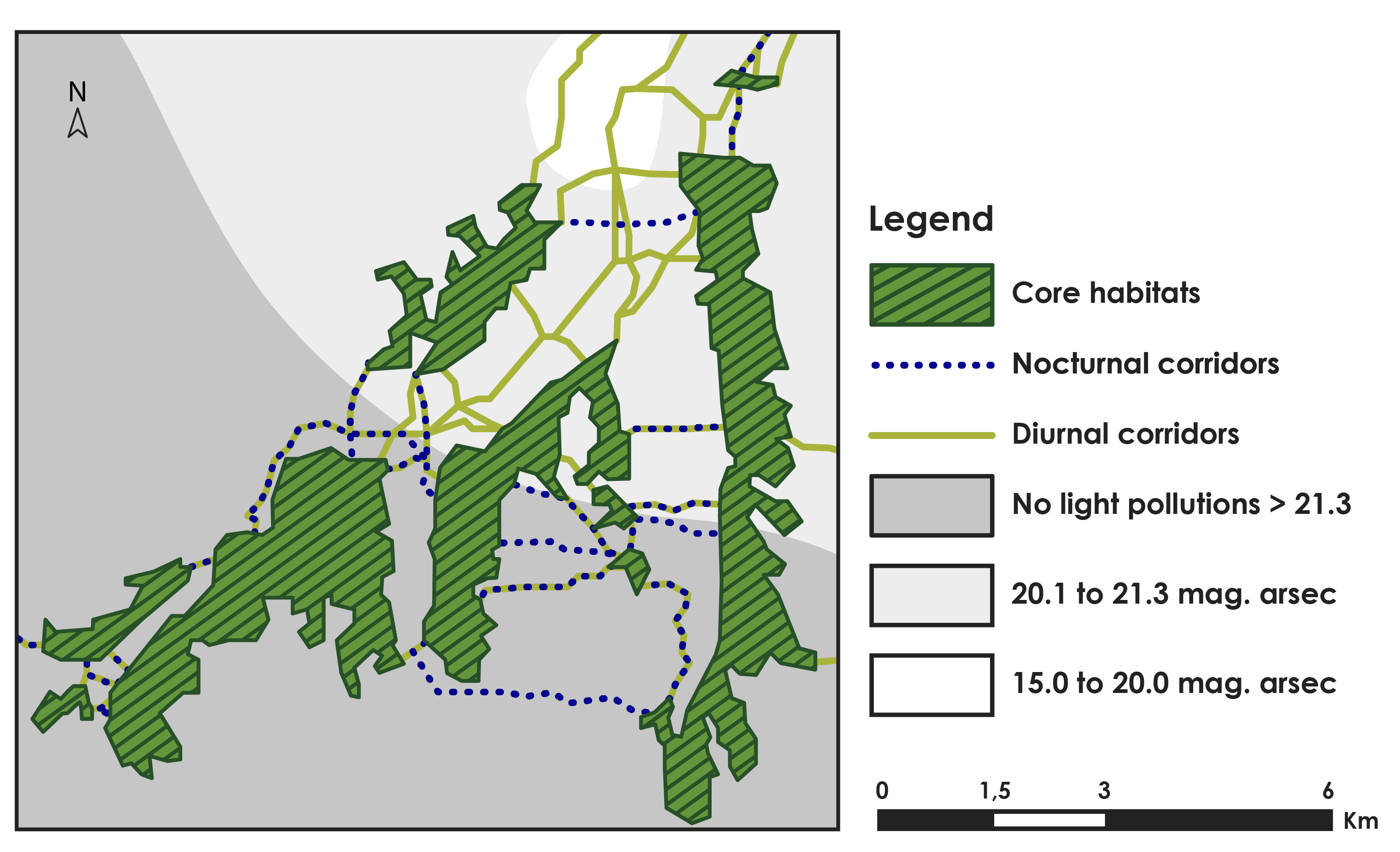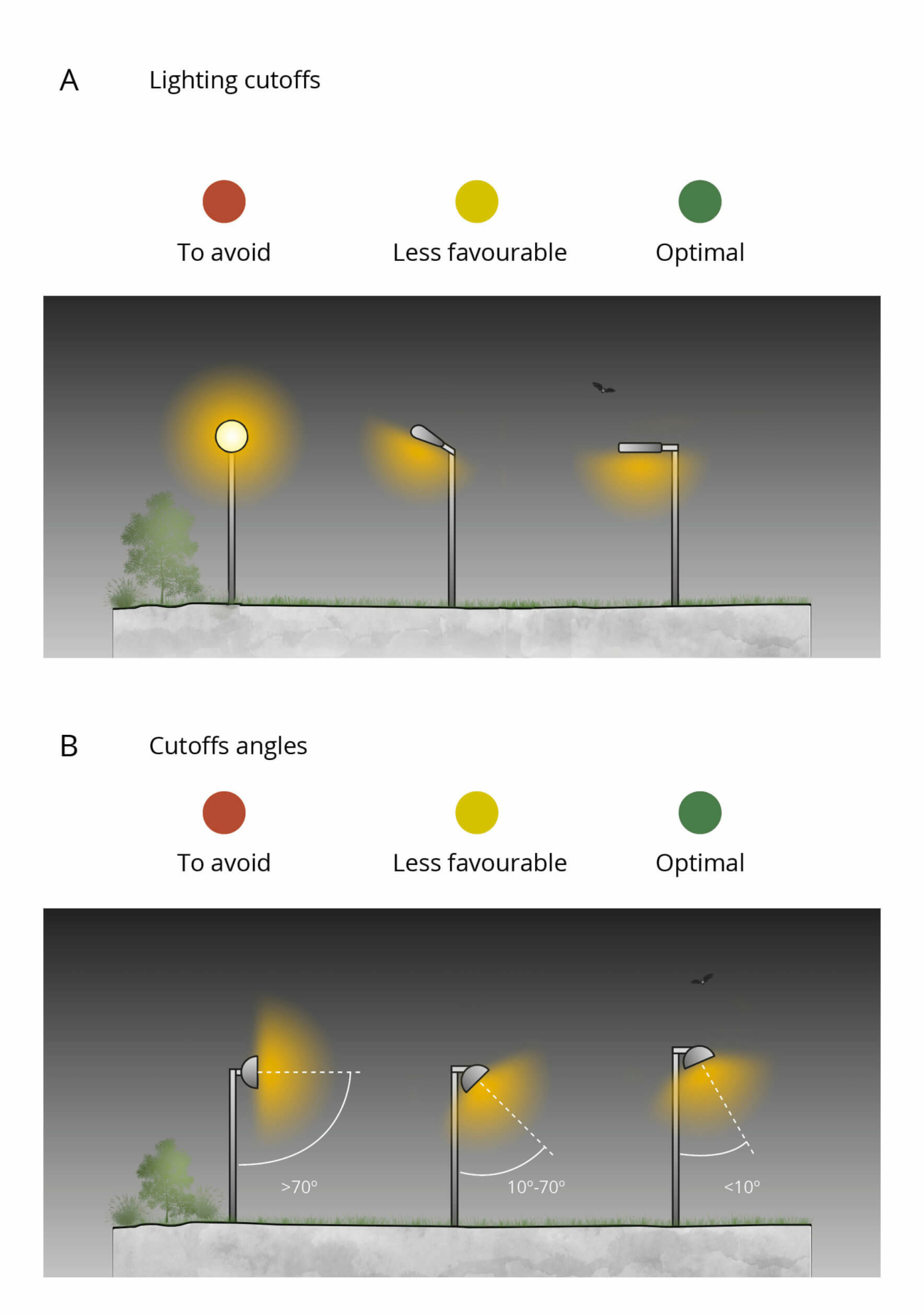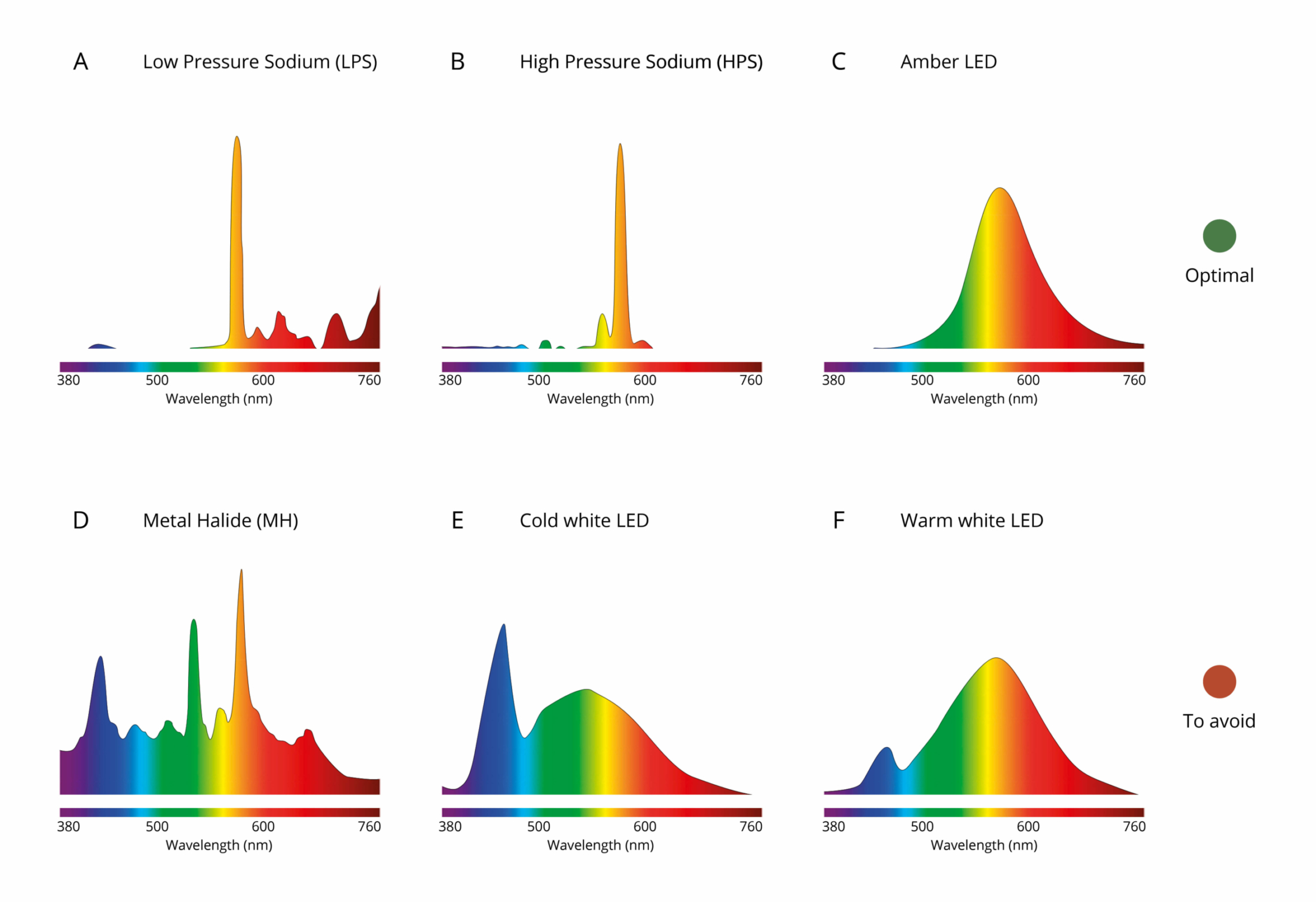Artificial light at night – from infrastructure lighting and possibly from vehicles – has diverse effects on wildlife, such as in reproduction, navigation or communication. It can also affect relationships between species, e.g. pollination or predation interactions. Lastly, artificial lighting throws animals’ biological clocks out of sync, whether they be nocturnal or diurnal (passerine birds, diurnal birds of prey). Plants are also affected; artificial lighting can cause budburst in urban trees to occur around a week early and delay autumn leaf-fall.
In behavioural terms, artificial light sources may attract or repel nocturnal animals, depending on their natural response to light (phototaxis). Artificial lighting is thus a factor that contributes to habitat degradation or to the loss of many species (bats, terrestrial mammals, fireflies and glow worms, etc.) entailing population-scale effects and even affecting the entire distribution area. This attraction or repulsion phenomenon has landscape-level repercussions and artificial lighting can create areas which are impassable to certain animals, finding themselves either drawn in or driven out. Artificial light at night therefore leads to habitat fragmentation and isolated nocturnal areas (see Chapter 1 – Ecological effects of infrastructure).
Some diachronic studies reveal that light pollution continues to escalate, especially in Europe, with a worldwide increase of around 6% per year.
A set of measures to reduce the effects of light are described in this section.
Planning infrastructure lighting using a ‘dark infrastructure’ approach
In view of the effects of light pollution, particularly at landscape level, it is crucial to preserve and restore an ecological network that will foster nocturnal wildlife. ‘Dark infrastructure’ can be defined as an ecological network of core habitats interconnected by ‘dark corridors’ which traverse a variety of landscape types and which are identified based on a level of darkness necessary to preserve nocturnal biodiversity (Figure 5.6.1). Sensitivity to light pollution differs depending on the species and limiting light to achieve a successful dark corridors concept should be based on the requirements of the most sensitive target species.
- Identification of dark corridors to be preserved from road lighting provides information which has an ongoing use during all phases of the infrastructure life-cycle to assist in the prevention of impacts from lighting on biodiversity.

- Lighting plans should consider international guidelines providing recommendations on light characteristics according to landscape zoning. Providing a dark environment is more important in natural protected areas and habitats which host most sensitive species (Table 5.6).
Table 5.6 – Environmental zone classification according to CIE 150 (2017). SQM (Sky Quality Measurements) are measured in mag/arcsec2.
| Environmental zone classification | |||
| Zone | Surrounding | Lighting environment | Examples |
| E0 | Protected | Dark (SQM1 20.5+) | UNESCO starlight reserves |
| E1 | Natural | Dark (SQM1 20 – 20.5) | National Parks |
| E2 | Rural | Low district brightness (SQM1 ~15 – 20) | Sparsely inhabited rural areas |
| E3 | Suburban | Medium district brightness | Well inhabited rural and urban settlements |
| E4 | Urban | High district brightness | Town/city centres with high levels of night-time activity |
- The guiding principle for any artificial lighting should be: ‘as much as necessary and as little as possible’. Moreover, there are various key parameters in night-time lighting that affect the level of light pollution in relation to biodiversity and which should therefore be appropriately adjusted to maintain or provide ‘dark Infrastructure’ conditions. These parameters can be divided into three categories: spatial, temporal and technical.
Spatial organization
The need to illuminate roads should be balanced against the consequences for surrounding nature.
- The installation of lights must be limited to those areas where it is strictly necessary due to the amount of traffic, weather conditions or accident hazard risks. When considering artificial illumination in any natural or sensitive area the first step is to question how useful the installation will be and weigh up the advantages it would provide to the local human population against the impact that it would create for fauna and flora, and on human health, if no mitigation measures are included.
- The positioning of planned infrastructure lighting can be modified to mitigate its impact on areas where it would be less useful and/or where wildlife would be adversely affected. Unnecessary lighting can be effectively reduced by the correct choice of the required light-radiation geometry.
- The ground surface also plays a determining role in the quantity of light emitted skywards, depending on its capacity to absorb or reflect light. Every material has a reflectance value indicating the extent to which it will reflect light rays. To reduce the impact of light on biodiversity in sensitive areas, it is preferable to select materials with low reflectance for installation under lights in order to reduce upward reflection.
- To reduce the impact of vehicle lights, installing screens or constructing earthen mounds on verges (see Section 5.6.2 – Noise) are appropriate mitigation measures, especially where the road traffic intensity is over 10,000 vehicles per day. Dimensions and locations of light screens should be precisely defined considering target species and habitats. Nevertheless, this measure will not completely avoid the impacts of skyglow and screens may require adaptation so as not to increase the barrier effect.
Temporal organization of artificial lighting
- In those areas where artificial lighting is deemed necessary, the illumination period should also be limited as much as possible, both daily and seasonally. The time periods when infrastructure lighting operates are crucial. The longer the lights are off the better it will be for local wildlife. Areas that are permanently illuminated must be as small as possible (Figure 5.6.2).
- Adjusting the lighting throughout the night, from late evening to early morning, is very important since many nocturnal animals are most active mainly at dusk and dawn. The biological activity of certain species, considered to be either diurnal or nocturnal, has been shown to adapt in order to maximise their ability to ‘see without being seen’, especially predators. In such cases activity may peak during the transition periods of dawn and dusk.
- Local authorities have developed initiatives to adapt street lighting that could also be applied to infrastructure lighting. Astronomical clocks and photocells to switch lighting on/off based on the time of sunrise/sunset or on the ambient light level could be used to adapt lighting period. ‘Smart’ lighting systems are also being developed, which provide illumination according to the users’ needs using remote controls or sensors. It is worth noting however that when lighting is switching on and off regularly throughout the night, it can potentially generate new issues for wildlife through the visual stimulus it creates.
Lamp specification
The design of the lamp influences its impact on wildlife.
- Lamps must direct light towards the desired area, always focused downward to limit light intrusion and avoid any emission of light above the horizontal plane. This can be achieved in different ways such as lowering the height of the light post as much as possible, setting the lamp at the proper angle and/or using shields or screens (Figure 5.6.3). River and waterway crossings deserve particular attention as fish and other freshwater wildlife are also affected by light. If bridges require lighting, it should not be directed at the water and riparian habitats.
- Different nocturnal species have different sensitivity regarding light wavelength and, therefore, there is no single solution which fits all situations. However, yellow/orange lights with wavelengths ~ 585nm have been recommended as the most beneficial, especially for insects and mammals. This is problematic for LED lights, which have a strong peak at blue wavelengths (~ 470nm). A potential solution is the Amber LED lamps with Narrow Spectrum (ALNS, without blue emission), although these have lower illumination efficiency. The effects on wildlife by LED technologies which emit ‘nearly’ monochromatic light, still need to be evaluated.
- The choice of different technologies for artificial lighting provides various solutions. The main categories of lamp used are listed below, highlighting those which generate low impacts on wildlife mainly emitting yellow, orange or red coloured light (Figure 5.6.4):
- Low Pressure Sodium (LPS) lamps (Figure 5.6.4A). Low impact on wildlife but no colour rendering. They have low energy consumption but this is an old technology that will soon be obsolete.
- High Pressure Sodium (HPS) lamps (Figure 5.6.4B). Low wildlife impact and good colour rendering.
- Metal Halide (MH) lamps (Figure 5.6.4D). High impact on wildlife. Strong illumination emitting in a yellow-green colour but also emit light at short wavelengths (blue). Only recommended to be used in small areas use where a powerful lighting device (> 1 kW) is needed and in non-sensitive natural areas.
- Amber LED lamps with Narrow Spectrum (Figure 5.6.4C) (ALNS, without blue emission). It is the only LED lamps with low impact on wildlife recommended in sensitive natural areas. It has medium efficiency (-30 to -70%) of illumination compared to Cold White LED (Figure 5.6.4E) and Warm White LED (Figure 5.6.4F).
Adaptive management approach
An evaluation of impacts after avoidance and reduction measures have been applied must be carried out with a view to further adaptation if required.
- An adaptive management approach should be implemented to monitor, correct, and improve any aspect of the lighting system affecting biodiversity. For example, biological surveys must be carried out to assess the effects of the lighting on mortality due to traffic or to evaluate if breeding or nesting periods for any sensitive species is being particularly affected. In these cases, further restrictions should be applied, always ensuring traffic safety. In the same way, maintenance monitoring must be performed to detect any lamp that is not properly installed or to fix/replace any mitigation measure that is not fulfilling its function.
- Compensation measures could be provided to offset impacts from lighting that cannot be reduced. For example, an equivalent alternative non-illuminated area connected by a network of ‘dark corridors’ must be provided to nocturnal species.


